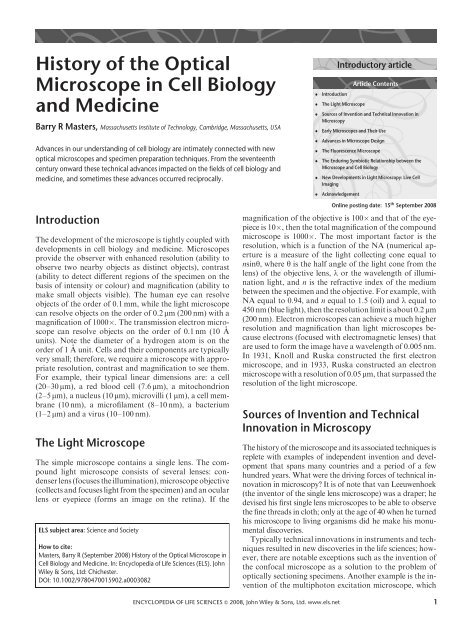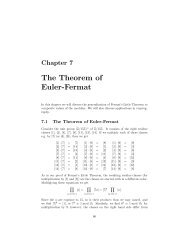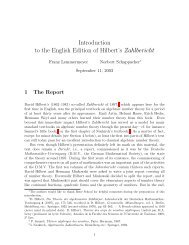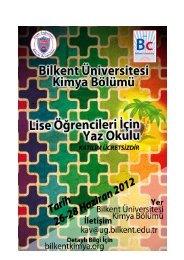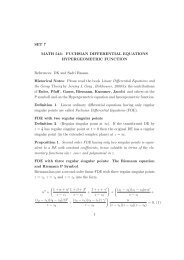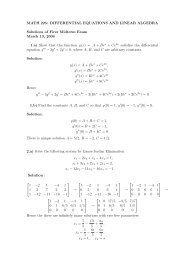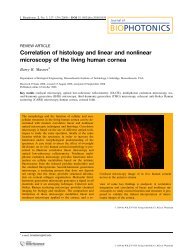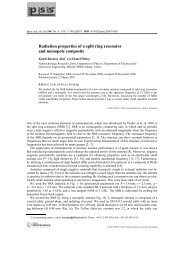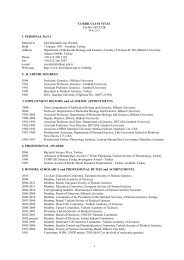History of the Optical Microscope in Cell Biology and Medicine
History of the Optical Microscope in Cell Biology and Medicine
History of the Optical Microscope in Cell Biology and Medicine
You also want an ePaper? Increase the reach of your titles
YUMPU automatically turns print PDFs into web optimized ePapers that Google loves.
<strong>History</strong> <strong>of</strong> <strong>the</strong> <strong>Optical</strong><br />
<strong>Microscope</strong> <strong>in</strong> <strong>Cell</strong> <strong>Biology</strong><br />
<strong>and</strong> Medic<strong>in</strong>e<br />
Barry R Masters, Massachusetts Institute <strong>of</strong> Technology, Cambridge, Massachusetts, USA<br />
Advances <strong>in</strong> our underst<strong>and</strong><strong>in</strong>g <strong>of</strong> cell biology are <strong>in</strong>timately connected with new<br />
optical microscopes <strong>and</strong> specimen preparation techniques. From <strong>the</strong> seventeenth<br />
century onward <strong>the</strong>se technical advances impacted on <strong>the</strong> fields <strong>of</strong> cell biology <strong>and</strong><br />
medic<strong>in</strong>e, <strong>and</strong> sometimes <strong>the</strong>se advances occurred reciprocally.<br />
Introduction<br />
The development <strong>of</strong> <strong>the</strong> microscope is tightly coupled with<br />
developments <strong>in</strong> cell biology <strong>and</strong> medic<strong>in</strong>e. <strong>Microscope</strong>s<br />
provide <strong>the</strong> observer with enhanced resolution (ability to<br />
observe two nearby objects as dist<strong>in</strong>ct objects), contrast<br />
(ability to detect different regions <strong>of</strong> <strong>the</strong> specimen on <strong>the</strong><br />
basis <strong>of</strong> <strong>in</strong>tensity or colour) <strong>and</strong> magnification (ability to<br />
make small objects visible). The human eye can resolve<br />
objects <strong>of</strong> <strong>the</strong> order <strong>of</strong> 0.1 mm, while <strong>the</strong> light microscope<br />
can resolve objects on <strong>the</strong> order <strong>of</strong> 0.2 mm (200 nm) with a<br />
magnification <strong>of</strong> 1000 . The transmission electron microscope<br />
can resolve objects on <strong>the</strong> order <strong>of</strong> 0.1 nm (10 A˚<br />
units). Note <strong>the</strong> diameter <strong>of</strong> a hydrogen atom is on <strong>the</strong><br />
order <strong>of</strong> 1 A ˚ unit. <strong>Cell</strong>s <strong>and</strong> <strong>the</strong>ir components are typically<br />
very small; <strong>the</strong>refore, we require a microscope with appropriate<br />
resolution, contrast <strong>and</strong> magnification to see <strong>the</strong>m.<br />
For example, <strong>the</strong>ir typical l<strong>in</strong>ear dimensions are: a cell<br />
(20–30 mm), a red blood cell (7.6 mm), a mitochondrion<br />
(2–5 mm), a nucleus (10 mm), microvilli (1 mm), a cell membrane<br />
(10 nm), a micr<strong>of</strong>ilament (8–10 nm), a bacterium<br />
(1–2 mm) <strong>and</strong> a virus (10–100 nm).<br />
The Light <strong>Microscope</strong><br />
The simple microscope conta<strong>in</strong>s a s<strong>in</strong>gle lens. The compound<br />
light microscope consists <strong>of</strong> several lenses: condenser<br />
lens (focuses <strong>the</strong> illum<strong>in</strong>ation), microscope objective<br />
(collects <strong>and</strong> focuses light from <strong>the</strong> specimen) <strong>and</strong> an ocular<br />
lens or eyepiece (forms an image on <strong>the</strong> ret<strong>in</strong>a). If <strong>the</strong><br />
ELS subject area: Science <strong>and</strong> Society<br />
How to cite:<br />
Masters, Barry R (September 2008) <strong>History</strong> <strong>of</strong> <strong>the</strong> <strong>Optical</strong> <strong>Microscope</strong> <strong>in</strong><br />
<strong>Cell</strong> <strong>Biology</strong> <strong>and</strong> Medic<strong>in</strong>e. In: Encyclopedia <strong>of</strong> Life Sciences (ELS). John<br />
Wiley & Sons, Ltd: Chichester.<br />
DOI: 10.1002/9780470015902.a0003082<br />
. Introduction<br />
Introductory article<br />
. The Light <strong>Microscope</strong><br />
Article Contents<br />
. Sources <strong>of</strong> Invention <strong>and</strong> Technical Innovation <strong>in</strong><br />
Microscopy<br />
. Early <strong>Microscope</strong>s <strong>and</strong> Their Use<br />
. Advances <strong>in</strong> <strong>Microscope</strong> Design<br />
. The Fluorescence <strong>Microscope</strong><br />
. The Endur<strong>in</strong>g Symbiotic Relationship between <strong>the</strong><br />
<strong>Microscope</strong> <strong>and</strong> <strong>Cell</strong> <strong>Biology</strong><br />
. New Developments <strong>in</strong> Light Microscopy: Live <strong>Cell</strong><br />
Imag<strong>in</strong>g<br />
. Acknowledgement<br />
Onl<strong>in</strong>e post<strong>in</strong>g date: 15 th September 2008<br />
magnification <strong>of</strong> <strong>the</strong> objective is 100 <strong>and</strong> that <strong>of</strong> <strong>the</strong> eyepiece<br />
is 10 , <strong>the</strong>n <strong>the</strong> total magnification <strong>of</strong> <strong>the</strong> compound<br />
microscope is 1000 . The most important factor is <strong>the</strong><br />
resolution, which is a function <strong>of</strong> <strong>the</strong> NA (numerical aperture<br />
is a measure <strong>of</strong> <strong>the</strong> light collect<strong>in</strong>g cone equal to<br />
ns<strong>in</strong>y, where y is <strong>the</strong> half angle <strong>of</strong> <strong>the</strong> light cone from <strong>the</strong><br />
lens) <strong>of</strong> <strong>the</strong> objective lens, l or <strong>the</strong> wavelength <strong>of</strong> illum<strong>in</strong>ation<br />
light, <strong>and</strong> n is <strong>the</strong> refractive <strong>in</strong>dex <strong>of</strong> <strong>the</strong> medium<br />
between <strong>the</strong> specimen <strong>and</strong> <strong>the</strong> objective. For example, with<br />
NA equal to 0.94, <strong>and</strong> n equal to 1.5 (oil) <strong>and</strong> l equal to<br />
450 nm (blue light), <strong>the</strong>n <strong>the</strong> resolution limit is about 0.2 mm<br />
(200 nm). Electron microscopes can achieve a much higher<br />
resolution <strong>and</strong> magnification than light microscopes because<br />
electrons (focused with electromagnetic lenses) that<br />
are used to form <strong>the</strong> image have a wavelength <strong>of</strong> 0.005 nm.<br />
In 1931, Knoll <strong>and</strong> Ruska constructed <strong>the</strong> first electron<br />
microscope, <strong>and</strong> <strong>in</strong> 1933, Ruska constructed an electron<br />
microscope with a resolution <strong>of</strong> 0.05 mm, that surpassed <strong>the</strong><br />
resolution <strong>of</strong> <strong>the</strong> light microscope.<br />
Sources <strong>of</strong> Invention <strong>and</strong> Technical<br />
Innovation <strong>in</strong> Microscopy<br />
The history <strong>of</strong> <strong>the</strong> microscope <strong>and</strong> its associated techniques is<br />
replete with examples <strong>of</strong> <strong>in</strong>dependent <strong>in</strong>vention <strong>and</strong> development<br />
that spans many countries <strong>and</strong> a period <strong>of</strong> a few<br />
hundred years. What were <strong>the</strong> driv<strong>in</strong>g forces <strong>of</strong> technical <strong>in</strong>novation<br />
<strong>in</strong> microscopy? It is <strong>of</strong> note that van Leeuwenhoek<br />
(<strong>the</strong> <strong>in</strong>ventor <strong>of</strong> <strong>the</strong> s<strong>in</strong>gle lens microscope) was a draper; he<br />
devised his first s<strong>in</strong>gle lens microscopes to be able to observe<br />
<strong>the</strong> f<strong>in</strong>e threads <strong>in</strong> cloth; only at <strong>the</strong> age <strong>of</strong> 40 when he turned<br />
his microscope to liv<strong>in</strong>g organisms did he make his monumental<br />
discoveries.<br />
Typically technical <strong>in</strong>novations <strong>in</strong> <strong>in</strong>struments <strong>and</strong> techniques<br />
resulted <strong>in</strong> new discoveries <strong>in</strong> <strong>the</strong> life sciences; however,<br />
<strong>the</strong>re are notable exceptions such as <strong>the</strong> <strong>in</strong>vention <strong>of</strong><br />
<strong>the</strong> confocal microscope as a solution to <strong>the</strong> problem <strong>of</strong><br />
optically section<strong>in</strong>g specimens. Ano<strong>the</strong>r example is <strong>the</strong> <strong>in</strong>vention<br />
<strong>of</strong> <strong>the</strong> multiphoton excitation microscope, which<br />
ENCYCLOPEDIA OF LIFE SCIENCES & 2008, John Wiley & Sons, Ltd. www.els.net 1
provided a solution to <strong>the</strong> problem <strong>of</strong> how to provide deeptissue<br />
imag<strong>in</strong>g with fluorescent dyes that absorb <strong>in</strong> <strong>the</strong> ultraviolet<br />
region without kill<strong>in</strong>g <strong>the</strong> cells.<br />
The development <strong>of</strong> various types <strong>of</strong> optical microscopes<br />
<strong>in</strong>corporated <strong>the</strong> follow<strong>in</strong>g components: microscope objectives<br />
that m<strong>in</strong>imize chromatic <strong>and</strong> o<strong>the</strong>r optical aberrations<br />
(image distortion), st<strong>and</strong>s that m<strong>in</strong>imize mechanical vibrations<br />
<strong>and</strong> sources <strong>of</strong> illum<strong>in</strong>ation from sunlight to lasers.<br />
Additionally, <strong>the</strong>re were new methods <strong>of</strong> fix<strong>in</strong>g <strong>and</strong> cutt<strong>in</strong>g<br />
specimens (microtomes), specimen sta<strong>in</strong><strong>in</strong>g techniques<br />
(dyes, sta<strong>in</strong>s, molecular probes) that <strong>in</strong>crease specimen contrast.<br />
Also important were <strong>the</strong> development <strong>of</strong> various<br />
optical methods that provide contrast (phase <strong>and</strong> differential<br />
<strong>in</strong>terference microscopes, fluorescence microscopes) for<br />
live cells, techniques for imag<strong>in</strong>g long-term live cell cultures<br />
(time-lapse <strong>and</strong> video-microscopy), optical techniques to<br />
provide optical section<strong>in</strong>g <strong>of</strong> specimens (confocal microscopes),<br />
<strong>and</strong> nonl<strong>in</strong>ear-optical imag<strong>in</strong>g techniques (multiphoton,<br />
harmonic generation <strong>and</strong> coherent anti-Stokes<br />
Raman microscopes). The history <strong>of</strong> <strong>the</strong> microscope is<br />
grounded <strong>in</strong> physics, specifically optics, but it <strong>in</strong>cludes<br />
glasses – <strong>the</strong>ir optical properties, <strong>the</strong>ir mechanical-<strong>the</strong>rmal<br />
properties <strong>and</strong> <strong>the</strong>ir manufacture <strong>and</strong> gr<strong>in</strong>d<strong>in</strong>g techniques –<br />
to produce optical components.<br />
Early <strong>Microscope</strong>s <strong>and</strong> Their Use<br />
The <strong>in</strong>vention <strong>of</strong> <strong>the</strong> microscope is credited to Zaccharias<br />
Janssen (1587–1638) <strong>and</strong> his son Hans Janssen (1534–<br />
1592), two Dutch eye glass makers who placed multiple<br />
lenses <strong>in</strong> a tube <strong>and</strong> observed <strong>the</strong> image was magnified.<br />
Antoni van Leeuwenhoek (1632–1723) used his s<strong>in</strong>gle<br />
lens microscope to observe s<strong>in</strong>gle bacterial cells <strong>and</strong> o<strong>the</strong>r<br />
microorganisms that he called ‘wee animalcules’. He studied<br />
many specimens <strong>in</strong>clud<strong>in</strong>g liver, bra<strong>in</strong>, fat <strong>and</strong> muscle<br />
tissues (sta<strong>in</strong>ed with a dye). Additionally, he observed <strong>the</strong><br />
cornea <strong>of</strong> <strong>the</strong> eye, <strong>the</strong> lens, <strong>the</strong> ret<strong>in</strong>a, <strong>the</strong> optic nerve, as well<br />
as biological fluids such as blood, ur<strong>in</strong>e, sweat <strong>and</strong> tears.<br />
van Leeuwenhoek observed <strong>the</strong> flow <strong>of</strong> blood globules<br />
(blood cells) <strong>in</strong> <strong>the</strong> capillaries <strong>in</strong> <strong>the</strong> gills <strong>of</strong> <strong>the</strong> tadpole; he<br />
noted that <strong>the</strong> flow was simultaneous with <strong>the</strong> heartbeat <strong>of</strong><br />
<strong>the</strong> tadpole. He was not aware <strong>of</strong> Malpighi’s discovery <strong>of</strong><br />
blood capillaries (1660) <strong>and</strong> red blood corpuscles (1674).<br />
In 1664 Robert Hooke (1635–1703), a contemporary <strong>of</strong><br />
Newton, published Micrographia, a book which attracted<br />
widespread attention to <strong>the</strong> microscope <strong>and</strong> its marvelous<br />
capabilities. Hooke wrote <strong>in</strong> <strong>the</strong> preface <strong>of</strong> Micrographia<br />
that his motivation for <strong>the</strong> book was to promote <strong>the</strong> use <strong>of</strong><br />
<strong>in</strong>struments <strong>in</strong> science. With his compound microscope <strong>and</strong><br />
an oil lamp as a light source, he observed <strong>the</strong> eye <strong>and</strong> <strong>the</strong><br />
morphology <strong>of</strong> common fly <strong>and</strong> he described <strong>the</strong> fruit<strong>in</strong>g<br />
structures <strong>of</strong> molds. Later <strong>in</strong> 1665, Hooke observed cells<br />
(similar to monk’s cells) <strong>in</strong> slices <strong>of</strong> cork <strong>and</strong> made similar<br />
observations <strong>of</strong> plant cells. Most importantly, he noted<br />
that <strong>the</strong> s<strong>in</strong>gle lens microscope is superior to <strong>the</strong> compound<br />
microscope s<strong>in</strong>ce <strong>the</strong> former had m<strong>in</strong>imal chromatic aberrations<br />
(different colours <strong>of</strong> light focus at different po<strong>in</strong>ts).<br />
2<br />
<strong>History</strong> <strong>of</strong> <strong>the</strong> <strong>Optical</strong> <strong>Microscope</strong> <strong>in</strong> <strong>Cell</strong> <strong>Biology</strong> <strong>and</strong> Medic<strong>in</strong>e<br />
A major advance <strong>in</strong> <strong>the</strong> design <strong>of</strong> microscope objectives<br />
occurred when Joseph Jackson Lister (1786–1869) developed<br />
his version <strong>of</strong> <strong>the</strong> achromatic objective with no spherical<br />
aberration. He used his new microscope objective<br />
(achromatic doublets <strong>and</strong> triplets that did not multiply <strong>the</strong><br />
spherical aberration <strong>and</strong> coma <strong>of</strong> each lens) to observe red<br />
blood cells <strong>and</strong> striated muscle. This was an important development<br />
because until <strong>the</strong> 1830s <strong>the</strong> compound microscope<br />
yielded low-quality images; on <strong>the</strong> contrary, <strong>the</strong><br />
s<strong>in</strong>gle lens microscope did not suffer from <strong>the</strong>se optical<br />
aberrations.<br />
Giaovanni Battista Amici (1786–1863) was ano<strong>the</strong>r <strong>in</strong>novator<br />
<strong>and</strong> developer <strong>of</strong> microscopes. He was <strong>the</strong> first to<br />
use an immersion objective to <strong>in</strong>crease <strong>the</strong> resolution (earlier<br />
suggested by Brewster). He used an ellipsoidal mirror<br />
objective to solve <strong>the</strong> problem <strong>of</strong> chromatic aberrations.<br />
This idea was first proposed by Christiaan Huygens as a<br />
method to avoid chromatic aberrations; earlier Newton<br />
made a similar proposal. Amici made three major improvements<br />
<strong>of</strong> <strong>the</strong> microscope: he developed a semispherical<br />
front lens achromatic microscope objective, he<br />
described <strong>the</strong> effect <strong>of</strong> coverslip thickness on image quality,<br />
<strong>and</strong> he <strong>in</strong>troduced <strong>the</strong> use <strong>of</strong> <strong>the</strong> water immersion microscope<br />
objectives.<br />
How were l<strong>in</strong>ear dimensions <strong>and</strong> resolution measured <strong>in</strong><br />
microscopes? The magnification <strong>of</strong> van Leeuwenhoek’s<br />
various microscopes ranged from 3 to 266 <strong>and</strong> <strong>the</strong><br />
resolution ranged from 1.3 to 8 mm. He measured size <strong>in</strong> his<br />
specimens by comparison with a gra<strong>in</strong> <strong>of</strong> s<strong>and</strong> or <strong>the</strong> diameter<br />
<strong>of</strong> a hair. Later, <strong>in</strong> <strong>the</strong> seventeenth <strong>and</strong> eighteenth<br />
centuries <strong>the</strong> resolv<strong>in</strong>g power <strong>of</strong> an objective was tested<br />
with <strong>the</strong> w<strong>in</strong>gs <strong>of</strong> <strong>in</strong>sects or <strong>the</strong> fea<strong>the</strong>rs <strong>of</strong> birds; <strong>and</strong> for<br />
higher resolution objectives, diatoms were <strong>the</strong> test objects.<br />
Over a period <strong>of</strong> decades <strong>the</strong> compound microscope<br />
began to atta<strong>in</strong> <strong>the</strong> look <strong>of</strong> <strong>the</strong> modern optical microscope.<br />
Christian Hertel (1683–1725) <strong>in</strong> 1712 developed <strong>the</strong> mechanical<br />
x–y stage to move <strong>the</strong> specimen with f<strong>in</strong>e mechanical<br />
control. In 1854, Camille Sebastien Nachet (1799–1881)<br />
<strong>in</strong>vented his version <strong>of</strong> <strong>the</strong> stereomicroscope that conta<strong>in</strong>ed<br />
two eyepieces. By 1897, <strong>the</strong> firm Zeiss manufactured its<br />
stereomicroscope that provided three-dimensional views <strong>of</strong><br />
<strong>the</strong> specimen.<br />
Advances <strong>in</strong> <strong>Microscope</strong> Design<br />
The credit for <strong>the</strong> first <strong>the</strong>oretical advances <strong>in</strong> microscope<br />
design based on physics is given to Ernst Abbe (1840–<br />
1906). In 1866, Abbe met Carl Zeiss, who proposed that<br />
Abbe establish a scientific foundation for <strong>the</strong> manufacture<br />
<strong>of</strong> optical microscopes. Abbe made <strong>the</strong>oretical contributions<br />
to <strong>the</strong> <strong>the</strong>ories <strong>of</strong> <strong>the</strong> resolv<strong>in</strong>g power <strong>of</strong> microscope,<br />
<strong>the</strong> role <strong>of</strong> diffraction <strong>in</strong> image formation, <strong>and</strong> <strong>the</strong> formation<br />
<strong>of</strong> aberrations. In 1872, Abbe formulated <strong>the</strong> ‘Abbe<br />
S<strong>in</strong>e Condition’ that permitted <strong>the</strong> design <strong>of</strong> objectives with<br />
maximum resolution <strong>and</strong> m<strong>in</strong>imal aberrations. He <strong>in</strong>vented<br />
<strong>the</strong> Abbe condenser <strong>in</strong> 1872 which illum<strong>in</strong>ated <strong>the</strong><br />
full aperture <strong>of</strong> <strong>the</strong> microscope objective <strong>and</strong> thus provided<br />
ENCYCLOPEDIA OF LIFE SCIENCES & 2008, John Wiley & Sons, Ltd. www.els.net
maximum resolution. In 1873, Abbe formulated <strong>the</strong> limit <strong>of</strong><br />
optical resolution <strong>of</strong> a microscope <strong>in</strong> terms <strong>of</strong> <strong>the</strong> numerical<br />
aperture <strong>and</strong> <strong>the</strong> wavelength <strong>of</strong> <strong>the</strong> <strong>in</strong>cident light. Fur<strong>the</strong>rmore,<br />
Abbe <strong>in</strong>vented apochromatized objectives (multiple<br />
colours <strong>of</strong> <strong>in</strong>cident light focus at <strong>the</strong> same po<strong>in</strong>t) <strong>in</strong> 1886;<br />
<strong>the</strong>se achromatic objectives provided a resolution <strong>of</strong> 1 mm,<br />
<strong>and</strong> this advance, toge<strong>the</strong>r with oil-immersion objectives,<br />
permitted <strong>the</strong> subsequent major discoveries <strong>in</strong> bacteriology<br />
<strong>and</strong> cell biology. The concept <strong>of</strong> <strong>the</strong> numerical aperture <strong>of</strong><br />
an objective is credited to Abbe.<br />
Later <strong>in</strong> <strong>the</strong> twentieth century <strong>the</strong>re were many sem<strong>in</strong>al<br />
developments <strong>in</strong> microscope design that improved <strong>the</strong> contrast<br />
<strong>of</strong> biological cells <strong>and</strong> tissues. Start<strong>in</strong>g <strong>in</strong> 1936 with <strong>the</strong><br />
development <strong>of</strong> a microscope photometer for quantitative<br />
microscopy Torbjo¨rn Caspersson, work<strong>in</strong>g <strong>in</strong> Stockholm,<br />
studied <strong>the</strong> absorption <strong>of</strong> various prote<strong>in</strong>s <strong>and</strong> subsequently<br />
developed <strong>the</strong> field <strong>of</strong> microscopic spectrophotometry<br />
<strong>of</strong> cells <strong>and</strong> tissues. He failed to construct a<br />
microscope-fluorometer because <strong>of</strong> <strong>the</strong> <strong>the</strong>n <strong>in</strong>surmountable<br />
problem <strong>of</strong> photobleach<strong>in</strong>g <strong>of</strong> fluorescent dyes dur<strong>in</strong>g<br />
ultraviolet excitation. In 1943, Evgenii Brumberg developed<br />
a microscope that used three colours <strong>of</strong> <strong>in</strong>cident light<br />
<strong>and</strong> produced images <strong>in</strong> full colour.<br />
Several <strong>in</strong>ventors <strong>in</strong>dependently solved <strong>the</strong> problems <strong>of</strong><br />
low contrast <strong>in</strong> th<strong>in</strong> objects, e.g. cell <strong>in</strong> culture. In 1931,<br />
L<strong>in</strong>nik developed his <strong>in</strong>terference microscope that provided<br />
<strong>in</strong>creased contrast. The Dutch physicist Frits Zernike<br />
(1881–1966) <strong>in</strong> 1934 solved <strong>the</strong> problem <strong>of</strong> <strong>the</strong> low contrast<br />
<strong>of</strong> liv<strong>in</strong>g cells <strong>in</strong> culture by <strong>in</strong>vent<strong>in</strong>g his phase contrast<br />
microscope (it converted differences <strong>in</strong> <strong>the</strong> phases <strong>of</strong> light<br />
from <strong>the</strong> different parts <strong>of</strong> <strong>the</strong> specimen <strong>in</strong>to light <strong>and</strong> dark<br />
<strong>in</strong>tensities that are easily observed). In 1943, researchers <strong>in</strong><br />
<strong>the</strong> Zeiss factory <strong>in</strong> Jena produced a time-lapse film <strong>of</strong> meiotic<br />
divisions <strong>in</strong> <strong>the</strong> spermatogenesis <strong>of</strong> grasshoppers; this<br />
film stimulated commercial <strong>in</strong>terest <strong>in</strong> phase contrast microscopy.<br />
Zernicke received <strong>the</strong> Nobel Prize <strong>in</strong> 1953 for his<br />
<strong>in</strong>vention <strong>of</strong> <strong>the</strong> phase contrast microscope. In 1956,<br />
Georges Nomarski <strong>in</strong>vented a differential-contrast microscope<br />
which also improved <strong>the</strong> contrast <strong>of</strong> live cells <strong>in</strong><br />
culture.<br />
TheFluorescence<strong>Microscope</strong><br />
The next problem to be solved was how to achieve improved<br />
specificity <strong>and</strong> contrast <strong>in</strong> optical microscopy; <strong>and</strong><br />
<strong>the</strong> solution was <strong>the</strong> application <strong>of</strong> fluorescence (<strong>in</strong>cident<br />
light <strong>of</strong> short wavelength caused a fluorescent molecule to<br />
emit light <strong>of</strong> a longer wavelength) to microscopy. The development<br />
<strong>of</strong> <strong>the</strong> fluorescence microscope followed a series<br />
<strong>of</strong> technical advances <strong>in</strong> microscope design as well as <strong>the</strong><br />
use <strong>of</strong> <strong>in</strong>tr<strong>in</strong>sic fluorescence molecules as well as syn<strong>the</strong>tic<br />
fluorescence molecules. In <strong>the</strong> former category are new<br />
sources <strong>of</strong> ultraviolet light, <strong>the</strong> use <strong>of</strong> liquid filters to separate<br />
specific wavelengths or colours <strong>of</strong> illum<strong>in</strong>ation, <strong>the</strong><br />
use <strong>of</strong> solid or liquid filters to separate <strong>the</strong> <strong>in</strong>cident excitation<br />
light from <strong>the</strong> emitted light that occurred at longer<br />
wavelengths, <strong>the</strong> design <strong>of</strong> objectives <strong>and</strong> lenses that can<br />
<strong>History</strong> <strong>of</strong> <strong>the</strong> <strong>Optical</strong> <strong>Microscope</strong> <strong>in</strong> <strong>Cell</strong> <strong>Biology</strong> <strong>and</strong> Medic<strong>in</strong>e<br />
transmit ultraviolet light, <strong>and</strong> photographic <strong>and</strong> solid-state<br />
detectors to record <strong>the</strong> images. In <strong>the</strong> latter category are<br />
organic dyes <strong>and</strong> sta<strong>in</strong>s as well as fluorescent dyes that are<br />
chemically bound to antibodies that can couple to a specific<br />
prote<strong>in</strong> <strong>in</strong> a cell, <strong>and</strong> <strong>the</strong>reby provide contrast <strong>in</strong> microscopy<br />
that has very high specificity (s<strong>in</strong>gle prote<strong>in</strong>) <strong>and</strong> results<br />
<strong>in</strong> high contrast images.<br />
The dye fluoresce<strong>in</strong> that was first syn<strong>the</strong>sized <strong>in</strong> 1871 has<br />
a long history connected with <strong>the</strong> cell sta<strong>in</strong><strong>in</strong>g. In 1881, <strong>the</strong><br />
bacteriologist Paul Ehrlich (1854–1915) used fluoresce<strong>in</strong> to<br />
observe <strong>the</strong> passage <strong>of</strong> aqueous humour <strong>in</strong> <strong>the</strong> eye. He also<br />
used various anil<strong>in</strong>e fluorescent dyes to sta<strong>in</strong> bacteria <strong>and</strong><br />
<strong>the</strong>reby <strong>in</strong>crease <strong>the</strong>ir contrast <strong>in</strong> <strong>the</strong> microscope.<br />
August Ko¨hler (1866–1948) work<strong>in</strong>g <strong>in</strong> <strong>the</strong> Jena Zeiss<br />
factory developed <strong>in</strong> 1893 a new system <strong>of</strong> microscope<br />
illum<strong>in</strong>ation (later named Ko¨hler illum<strong>in</strong>ation) for photomicrographic<br />
purposes. He also made microscope observations<br />
<strong>of</strong> aut<strong>of</strong>luorescence (self-fluorescence) <strong>of</strong> biological<br />
specimens excited with ultraviolet light. He observed <strong>the</strong><br />
ultraviolet image <strong>of</strong> unsta<strong>in</strong>ed chromat<strong>in</strong> <strong>in</strong> <strong>the</strong> cell nucleus<br />
with <strong>in</strong>cident light <strong>of</strong> 275 nm.<br />
In 1903, Henry Friedrich Wilhelm Siedentopf (1872–<br />
1940) <strong>and</strong> Richard Adolf Zsigmondy (1865–1929) <strong>in</strong>vented<br />
<strong>the</strong> ultra-microscope to observe colloids. Henry Friedrich<br />
Wilhelm Siedentopf constructed a dark-field condenser<br />
that blocked <strong>the</strong> <strong>in</strong>cident light from enter<strong>in</strong>g <strong>the</strong> microscope<br />
objective, <strong>the</strong>reby improv<strong>in</strong>g <strong>the</strong> specimen’s contrast.<br />
Henry Friedrich Wilhelm Siedentopf first reported<br />
that <strong>the</strong> use <strong>of</strong> ultraviolet light produced specimen fluorescence,<br />
<strong>and</strong> that was a problem s<strong>in</strong>ce it reduced <strong>the</strong> specimen’s<br />
contrast!<br />
Then <strong>in</strong> 1904, August Ko¨hler <strong>in</strong>vented <strong>the</strong> ultraviolet<br />
microscope that preceded <strong>the</strong> fluorescence microscope.<br />
A camera was required to detect <strong>the</strong> very weak image.<br />
Ko¨hler used <strong>the</strong> quartz monochromatic ultraviolet objective<br />
previously developed by Moritz von Rohr. The motivation<br />
to use ultraviolet light was based on <strong>the</strong> fact that<br />
shorter wavelengths <strong>of</strong> <strong>in</strong>cident light result <strong>in</strong> <strong>in</strong>creased<br />
resolution <strong>of</strong> optical microscopes (from <strong>the</strong> work <strong>of</strong> Abbe).<br />
By 1910, Lehmann <strong>of</strong> <strong>the</strong> Carl Zeiss factory <strong>in</strong> Jena used<br />
<strong>the</strong> light source developed by <strong>the</strong> American Robert Wood<br />
(1868–1955) to make a prototype fluorescence microscope.<br />
In 1913, <strong>the</strong> Zeiss firm <strong>in</strong>troduced its lum<strong>in</strong>escence microscope.<br />
Subsequently Max Hait<strong>in</strong>ger (1868–1946) <strong>in</strong>troduced<br />
<strong>the</strong> term ‘fluorochrom<strong>in</strong>g’ or fluorescent sta<strong>in</strong><strong>in</strong>g <strong>of</strong><br />
specimens, <strong>and</strong> he developed many <strong>of</strong> <strong>the</strong> sta<strong>in</strong><strong>in</strong>g techniques<br />
for <strong>the</strong> observation <strong>of</strong> specimens <strong>in</strong> <strong>the</strong> fluorescence<br />
microscope.<br />
At <strong>the</strong> same time Carl Reichert <strong>of</strong> Vienna developed a<br />
compet<strong>in</strong>g fluorescence microscope with a new dark-field<br />
quartz condenser (<strong>the</strong> ultraviolet light did not enter <strong>the</strong><br />
microscope objective, it only excited <strong>the</strong> specimen to fluoresce).<br />
In 1911, Hans Stu¨bel observed aut<strong>of</strong>luorescence<br />
(naturally occurr<strong>in</strong>g fluorescence without <strong>the</strong> application<br />
<strong>of</strong> a fluorescence dye to <strong>the</strong> specimen) dur<strong>in</strong>g his microscopic<br />
studies <strong>of</strong> cells <strong>and</strong> tissues. Subsequent observations<br />
by Herwig Hamperl (University <strong>of</strong> Vienna) who <strong>in</strong>itiated<br />
<strong>the</strong> use <strong>of</strong> <strong>the</strong> fluorescence microscope <strong>in</strong> pathology<br />
ENCYCLOPEDIA OF LIFE SCIENCES & 2008, John Wiley & Sons, Ltd. www.els.net 3
confirmed <strong>the</strong> aut<strong>of</strong>luorescence <strong>of</strong> <strong>the</strong> ocular lens <strong>of</strong> <strong>the</strong> eye,<br />
plant tissues, chlorophyll, amyloid, collagen, fibr<strong>in</strong> <strong>and</strong><br />
elastic fibers. von Prowazek (1875–1915) was <strong>the</strong> first to<br />
<strong>in</strong>troduce cellular sta<strong>in</strong><strong>in</strong>g <strong>in</strong>to fluorescence microscope,<br />
i.e. his sta<strong>in</strong><strong>in</strong>g <strong>of</strong> liv<strong>in</strong>g protozoa.<br />
Philipp Ell<strong>in</strong>ger <strong>in</strong> <strong>the</strong> 1920s was <strong>in</strong>strumental <strong>in</strong> <strong>the</strong> development<br />
<strong>of</strong> <strong>the</strong> <strong>in</strong>travital fluorescence microscope. Ell<strong>in</strong>ger<br />
collorborated with August Hirt on its development. In<br />
1933, Ell<strong>in</strong>ger who was Jewish had to leave his position <strong>and</strong><br />
subsequently Hirt who was a member <strong>of</strong> <strong>the</strong> Nazi SS<br />
claimed that he alone was <strong>the</strong> <strong>in</strong>ventor <strong>of</strong> <strong>the</strong> <strong>in</strong>travital<br />
fluorescence microscope.<br />
In 1929, <strong>the</strong> firm Carl Zeiss <strong>in</strong> Jena produced an <strong>in</strong>travital<br />
microscope with vertical illum<strong>in</strong>ation, a waterimmersion<br />
microscope objective <strong>and</strong> an ultraviolet light<br />
source for <strong>the</strong> <strong>in</strong>vestigations <strong>of</strong> <strong>the</strong> distribution <strong>of</strong> fluorescent<br />
dyes <strong>in</strong> <strong>the</strong> kidneys <strong>and</strong> <strong>the</strong> liver <strong>of</strong> frogs <strong>and</strong> mice. This<br />
microscope was subsequently used for <strong>in</strong>travital observations<br />
<strong>of</strong> liv<strong>in</strong>g sk<strong>in</strong>, liver <strong>and</strong> kidney, <strong>and</strong> to study <strong>the</strong> microcirculation<br />
<strong>of</strong> organs <strong>and</strong> gl<strong>and</strong>s <strong>in</strong> <strong>the</strong> liv<strong>in</strong>g animal. By<br />
1932 various firms manufactured <strong>in</strong>travital microscopes<br />
<strong>and</strong> <strong>the</strong>y were used to study <strong>the</strong> microvasculature, liv<strong>in</strong>g<br />
sk<strong>in</strong>, liver <strong>and</strong> kidney.<br />
Several later developments improved <strong>the</strong> fluorescence<br />
microscope <strong>and</strong> resulted <strong>in</strong> its widespread use by cell biologists.<br />
In 1947 Siegfried Strugger (Mu¨nster), who previously<br />
developed <strong>the</strong> vital dye neutral red to sta<strong>in</strong> plant cells,<br />
used acrid<strong>in</strong>e orange (a cellular sta<strong>in</strong>) to differentiate live<br />
cells from dead cells. Strugger wrote a book on <strong>the</strong>se studies:<br />
Fluorescence Microscopy <strong>and</strong> Microbiology. A major<br />
advance <strong>in</strong> <strong>the</strong> <strong>in</strong>cident-light fluorescence microscope was<br />
<strong>the</strong> 1948 <strong>in</strong>vention by Evgenii Brumberg <strong>and</strong> later developed<br />
by Ploem (1967) <strong>of</strong> <strong>the</strong> dichromatic beam-splitt<strong>in</strong>g<br />
plate that is used to separate <strong>the</strong> excitation light from <strong>the</strong><br />
longer wavelength fluorescence. Albert Coons (1912–1978)<br />
<strong>and</strong> Melv<strong>in</strong> Kaplan are <strong>the</strong> <strong>in</strong>ventors <strong>of</strong> immun<strong>of</strong>luorescence<br />
(1950) <strong>in</strong> which a fluorescent dye is chemically attached<br />
to an antibody; this technique resulted <strong>in</strong> an<br />
enormous <strong>in</strong>crease <strong>in</strong> specificity (due to <strong>the</strong> antigen–antibody<br />
specificity) <strong>and</strong> resulted <strong>in</strong> many advances <strong>in</strong> cell biology.<br />
For example, <strong>in</strong> 1982 Mary Osborne <strong>and</strong> Klaus<br />
Weber used <strong>the</strong> fluorescence microscope toge<strong>the</strong>r with<br />
fluorescent monoclonal antibodies to visualize <strong>the</strong> cytoskeleton<br />
prote<strong>in</strong> tubul<strong>in</strong> <strong>in</strong> cells.<br />
The Endur<strong>in</strong>g Symbiotic Relationship<br />
between <strong>the</strong> <strong>Microscope</strong> <strong>and</strong> <strong>Cell</strong><br />
<strong>Biology</strong><br />
Dur<strong>in</strong>g <strong>the</strong> second half <strong>of</strong> <strong>the</strong> seventeenth century humans<br />
for <strong>the</strong> first time observed <strong>the</strong> microscopic world: unicellular<br />
organisms, plant cells, spermatozoa, <strong>the</strong> f<strong>in</strong>e structure<br />
<strong>of</strong> <strong>in</strong>sect w<strong>in</strong>gs <strong>and</strong> compound eyes, <strong>and</strong> capillaries <strong>of</strong><br />
<strong>the</strong> vascular system. Microscopic observations such as<br />
Leeuwenhoek’s observation <strong>of</strong> spermatozoa stimulated<br />
new <strong>the</strong>ories <strong>of</strong> generation; similarly <strong>the</strong> observation <strong>of</strong><br />
4<br />
<strong>History</strong> <strong>of</strong> <strong>the</strong> <strong>Optical</strong> <strong>Microscope</strong> <strong>in</strong> <strong>Cell</strong> <strong>Biology</strong> <strong>and</strong> Medic<strong>in</strong>e<br />
capillaries <strong>in</strong> an organism provoked new directions <strong>in</strong> <strong>the</strong><br />
concept <strong>of</strong> gl<strong>and</strong>ular action. The microscope proved not<br />
only to be a useful tool to facilitate <strong>the</strong> observation <strong>of</strong> microorganisms,<br />
but it became a critical tool <strong>in</strong> determ<strong>in</strong><strong>in</strong>g<br />
how biologists conceptualized cells <strong>and</strong> life itself. Two examples<br />
<strong>of</strong> its use <strong>in</strong> conceptualiz<strong>in</strong>g life are <strong>the</strong> <strong>the</strong>ory <strong>of</strong> <strong>the</strong><br />
cell as a unit <strong>of</strong> liv<strong>in</strong>g organisms, <strong>and</strong> use <strong>in</strong> overturn<strong>in</strong>g <strong>the</strong><br />
<strong>the</strong>ory <strong>of</strong> spontaneous generation (<strong>in</strong> which liv<strong>in</strong>g organisms<br />
were thought to be formed <strong>in</strong> putrefied organic<br />
matter).<br />
Jan Swammerdam (1637–1680) observed erythrocytes<br />
(red blood cells) with a s<strong>in</strong>gle lens microscope. He developed<br />
many techniques to improve <strong>the</strong> contrast <strong>of</strong> his specimens,<br />
such as <strong>the</strong> <strong>in</strong>jection <strong>of</strong> coloured liquids <strong>in</strong>to vessels<br />
<strong>and</strong> <strong>the</strong> use <strong>of</strong> coloured sta<strong>in</strong>s. His ma<strong>in</strong> work <strong>in</strong>volved <strong>the</strong><br />
use <strong>of</strong> <strong>the</strong> microscope to study <strong>the</strong> structure <strong>of</strong> <strong>the</strong> body <strong>of</strong><br />
<strong>in</strong>sects dur<strong>in</strong>g different states <strong>of</strong> development, <strong>the</strong>ir respiratory<br />
<strong>and</strong> circulatory systems, <strong>the</strong>ir alimentary tracts <strong>and</strong><br />
<strong>the</strong>ir reproductive organs. Additionally, he observed <strong>the</strong><br />
compound eye <strong>of</strong> <strong>the</strong> bee. Swammerdam’s microscopic<br />
observations were motivated by his deep reverence for<br />
God’s works.<br />
Marcello Malpighi (1628–1694) established <strong>the</strong> field <strong>of</strong><br />
microscopic anatomy <strong>in</strong> Bologna where he discovered<br />
blood capillaries, observed <strong>the</strong> bra<strong>in</strong>, <strong>the</strong> tongue <strong>and</strong> <strong>the</strong><br />
ret<strong>in</strong>a, <strong>and</strong> <strong>the</strong> development <strong>of</strong> <strong>the</strong> chicken embryo. He<br />
studied <strong>the</strong> lungs, <strong>the</strong> lymph nodes <strong>and</strong> gl<strong>and</strong>s, <strong>and</strong> <strong>the</strong><br />
bra<strong>in</strong>. His research dur<strong>in</strong>g 30 years at <strong>the</strong> University <strong>of</strong><br />
Bologna focused on <strong>the</strong> physiological function <strong>of</strong> <strong>the</strong> human<br />
body, but he also studied a range <strong>of</strong> o<strong>the</strong>r animals such<br />
as fish, fowl, frogs <strong>and</strong> domestic animals. He is honoured<br />
by hav<strong>in</strong>g his name associated with <strong>the</strong> follow<strong>in</strong>g structures:<br />
<strong>the</strong> Malpighi layer <strong>in</strong> sk<strong>in</strong>, to Malpighian tubules <strong>in</strong><br />
<strong>in</strong>sects, <strong>and</strong> <strong>the</strong> Malpighian tubules <strong>in</strong> <strong>the</strong> kidneys <strong>and</strong> <strong>the</strong><br />
spleen.<br />
Johannes Evangelista Purk<strong>in</strong>je (1787–1869) who co<strong>in</strong>ed<br />
<strong>the</strong> word protoplasm for <strong>the</strong> <strong>in</strong>side <strong>of</strong> cells was an experimental<br />
physiologist, embryologist <strong>and</strong> histologist. He<br />
used a compound microscope <strong>in</strong> his research <strong>and</strong> was <strong>the</strong><br />
first to use a microtome to cut th<strong>in</strong> sections <strong>of</strong> his specimens.<br />
He discovered Purk<strong>in</strong>je neurons <strong>in</strong> <strong>the</strong> cortex <strong>of</strong> <strong>the</strong><br />
cerebellum <strong>and</strong> <strong>the</strong> sweat gl<strong>and</strong>s <strong>in</strong> <strong>the</strong> sk<strong>in</strong>. In his embryological<br />
research he co<strong>in</strong>ed <strong>the</strong> term ‘protoplasm’. In<br />
1839, Purk<strong>in</strong>je discovered excitatory fibres <strong>in</strong> <strong>the</strong> heart that<br />
are named after him; <strong>the</strong> Purk<strong>in</strong>je fibres are situated <strong>in</strong> <strong>the</strong><br />
<strong>in</strong>ner walls <strong>of</strong> <strong>the</strong> ventricles <strong>of</strong> <strong>the</strong> heart.<br />
Robert Brown (1773–1858) used s<strong>in</strong>gle lens microscope<br />
<strong>in</strong> his research. He discovered <strong>the</strong> nucleus <strong>of</strong> cells <strong>in</strong> plants,<br />
<strong>and</strong> whereas observ<strong>in</strong>g solutions <strong>of</strong> pollen gra<strong>in</strong>s he discovered<br />
‘Brownian motion’. He also observed cytoplasmic<br />
stream<strong>in</strong>g. Leeuwenhoek first observed what was later<br />
named <strong>the</strong> nucleus, but Brown <strong>in</strong> 1833 named <strong>the</strong> nucleus<br />
as <strong>the</strong> large object <strong>in</strong> <strong>the</strong> cell.<br />
The German physiologist, Theodor Schwann (1810–<br />
1882), <strong>and</strong> <strong>the</strong> German botanist, Matthias Jakob Schleiden<br />
(1804–1881) who encouraged Carl Zeiss to develop new<br />
<strong>and</strong> improved microscopes, collaborated <strong>and</strong> developed<br />
<strong>the</strong>ir cell <strong>the</strong>ory, <strong>in</strong> which cells are <strong>the</strong> basic unit <strong>of</strong><br />
ENCYCLOPEDIA OF LIFE SCIENCES & 2008, John Wiley & Sons, Ltd. www.els.net
organisms. Schleiden’s most important scientific works<br />
are Beitra¨ge zur Phytogenesis (1838) <strong>and</strong> Grundzu¨ge der<br />
Wissenschaftlichen Botanik (1842). In 1858, Schleiden<br />
published his popular book The Plants <strong>and</strong> Their Lives.<br />
Schwann used <strong>the</strong> microscope to observe <strong>the</strong> notochord,<br />
cartilage, lens <strong>of</strong> <strong>the</strong> eye, ganglion <strong>and</strong> pigment cells <strong>and</strong><br />
confirmed <strong>the</strong>ir cellular composition. In 1839, Schwann<br />
proposed that both animals <strong>and</strong> plants are composed <strong>of</strong><br />
cells. Schwann <strong>and</strong> Schleiden held <strong>the</strong> <strong>in</strong>correct concept<br />
that cell develop from outside <strong>of</strong> cells; <strong>the</strong>ir concept <strong>of</strong> cell<br />
formation was eventually discredited <strong>and</strong> shown to be<br />
false.<br />
The German botanist Ferd<strong>in</strong><strong>and</strong> Cohn (1828–1898) is<br />
<strong>the</strong> founder <strong>of</strong> bacteriology. He used a microscope to <strong>in</strong>vestigate<br />
growth <strong>and</strong> division <strong>of</strong> plant cells. Additionally,<br />
he studied <strong>the</strong> life cycle <strong>of</strong> Bacillus as an example <strong>of</strong> <strong>the</strong><br />
heat-resistant forms <strong>of</strong> bacteria. He demonstrated that<br />
when bacteria form endospores <strong>the</strong>y can not be killed by<br />
heat sterilization.<br />
The fa<strong>the</strong>r <strong>of</strong> cellular pathology is Rudolf Virchow<br />
(1821–1902) who advocated <strong>the</strong> use <strong>of</strong> <strong>the</strong> microscope <strong>in</strong><br />
pathology. Virchow, <strong>in</strong> 1858, wrote ‘all cells derive from<br />
cells’. In this statement Virchow refuted <strong>the</strong> <strong>in</strong>correct<br />
claims on cell formation made by Schwann <strong>and</strong> Schleiden.<br />
His sem<strong>in</strong>al book <strong>Cell</strong>ular Pathology demonstrated that<br />
diseases are <strong>the</strong> consequence <strong>of</strong> a disruption <strong>of</strong> normal cellular<br />
processes (Figure 1).<br />
The French chemist Louis Pasteur (1882–1895) performed<br />
experiments that resulted <strong>in</strong> <strong>the</strong> overthrow <strong>of</strong> <strong>the</strong><br />
<strong>the</strong>ory <strong>of</strong> spontaneous generation. From 1880 to 1890 he<br />
developed vacc<strong>in</strong>es for <strong>the</strong> diseases anthrax, cholera <strong>and</strong><br />
rabies, <strong>and</strong> helped to support <strong>the</strong> germ <strong>the</strong>ory <strong>of</strong> diseases<br />
that was be<strong>in</strong>g developed by his contemporary Robert<br />
Koch. Louis Pasteur demonstrated that microorganisms<br />
are responsible for <strong>the</strong> purification <strong>of</strong> organic matter.<br />
Pasteur is also credited with <strong>the</strong> discovery <strong>of</strong> pasteurization<br />
to preserved food products (Figure 2).<br />
The Russian biologist Ilya Metchnik<strong>of</strong>f (1845–1916),<br />
who worked with Pasteur <strong>in</strong> Paris, discovered <strong>the</strong><br />
phagocytosis <strong>of</strong> bacteria by leucocytes <strong>and</strong> also <strong>in</strong>vestigated<br />
<strong>the</strong> pathogenesis <strong>of</strong> cholera. In 1908, Metchnik<strong>of</strong>f<br />
<strong>and</strong> Paul Ehrlich (1854–1915) who developed <strong>the</strong> humoral<br />
<strong>the</strong>ory <strong>of</strong> immunity shared <strong>the</strong> Nobel Prize.<br />
Robert Koch (1843–1919) is <strong>the</strong> founder <strong>of</strong> a sem<strong>in</strong>al<br />
school <strong>of</strong> bacteriology; his students were among <strong>the</strong> important<br />
leaders <strong>in</strong> European <strong>and</strong> American bacteriology.<br />
In 1881, Koch developed experimental techniques, i.e. microscopy,<br />
sta<strong>in</strong><strong>in</strong>g <strong>of</strong> tissues, growth <strong>of</strong> bacteria on solid<br />
culture media, pure culture isolation <strong>and</strong> animal <strong>in</strong>oculation<br />
to underst<strong>and</strong> <strong>the</strong> role <strong>of</strong> Mycobacterium tuberculosis<br />
<strong>in</strong> <strong>the</strong> transmission <strong>and</strong> progression <strong>of</strong> tuberculosis. Koch<br />
is credited with methods to study bacteria <strong>in</strong> pure culture.<br />
Koch conceptualized <strong>the</strong> germ <strong>the</strong>ory <strong>of</strong> disease<br />
<strong>and</strong> provided experimental evidence <strong>in</strong> its support. He devised<br />
Koch’s postulates for <strong>the</strong> experimental study <strong>of</strong> <strong>in</strong>fectious<br />
diseases. He made <strong>the</strong> first photomicrographs <strong>of</strong><br />
bacteria (microscope <strong>and</strong> camera), developed microscopic<br />
pathology, <strong>and</strong> <strong>the</strong> methodology for dis<strong>in</strong>fection <strong>and</strong><br />
<strong>History</strong> <strong>of</strong> <strong>the</strong> <strong>Optical</strong> <strong>Microscope</strong> <strong>in</strong> <strong>Cell</strong> <strong>Biology</strong> <strong>and</strong> Medic<strong>in</strong>e<br />
Figure 1 <strong>Microscope</strong> st<strong>and</strong> IV, No. 3207 manufactured by Oberhaeuser <strong>and</strong><br />
Hartnack <strong>in</strong> Paris, France, <strong>in</strong> 1858. This microscope has a drum st<strong>and</strong> <strong>and</strong><br />
polariz<strong>in</strong>g equipment. This type <strong>of</strong> microscope was used by Rudolf Virchow <strong>in</strong><br />
Berl<strong>in</strong>, Germany. All photos # by Timo Mappes, Karlsruhe<br />
(www.musopt<strong>in</strong>.com) <strong>and</strong> reproduced by permission.<br />
sterilization. He was awarded <strong>the</strong> 1905 Nobel Prize for<br />
Physiology <strong>and</strong> Medic<strong>in</strong>e. Koch was an <strong>in</strong>novator <strong>in</strong> microscopy:<br />
he was <strong>the</strong> first to use an oil immersion objective<br />
<strong>and</strong> <strong>the</strong> Abbe condenser (with a lens system to fill <strong>the</strong> entire<br />
aperture <strong>of</strong> <strong>the</strong> microscope objective <strong>and</strong> thus achieve<br />
maximum resolution), <strong>the</strong> first to publish photomicrographs<br />
<strong>of</strong> bacteria, <strong>and</strong> he devised sta<strong>in</strong><strong>in</strong>g methods for<br />
bacteria to <strong>in</strong>crease <strong>the</strong>ir contrast <strong>in</strong> <strong>the</strong> microscope.<br />
Koch developed <strong>the</strong> science <strong>of</strong> microbiology. In 1873 he<br />
studied anthrax <strong>and</strong> published <strong>in</strong> 1877 <strong>the</strong> life cycle <strong>of</strong> Bacillus<br />
anthracis. Koch used air-dried films on cover slips<br />
that he sta<strong>in</strong>ed with <strong>the</strong> anil<strong>in</strong>e dyes that Ehrlich <strong>in</strong>troduced<br />
<strong>in</strong>to microbiology. In 1875, he discovered <strong>the</strong> tubercle bacilli<br />
<strong>and</strong> he discovered <strong>the</strong> pathogen <strong>of</strong> Cholera. In <strong>the</strong>se<br />
sem<strong>in</strong>al studies Koch obta<strong>in</strong>ed <strong>the</strong> first photomicrographs<br />
<strong>of</strong> bacteria <strong>in</strong> diseased tissue. Koch used a Zeiss microscope<br />
with a b<strong>in</strong>ocular eyepiece, a mechanical stage <strong>and</strong> an Abbe<br />
illum<strong>in</strong>ator as well as an objective revolver. Koch also used<br />
a microscope produced by <strong>the</strong> firm Seibert <strong>and</strong> Krafft located<br />
<strong>in</strong> Wetzlar. In 1878, he published his book, Aetiology<br />
<strong>of</strong> Tramatic Infective Diseases.<br />
It was common for researchers to use a variety <strong>of</strong> microscopes<br />
from different manufacturers <strong>in</strong> <strong>the</strong>ir work.<br />
The firm Reichert located <strong>in</strong> Vienna produced high-quality<br />
microscopes that were used by Louis Pasteur, Rudolf<br />
Virchow <strong>and</strong> Robert Koch. The firm Nachet located <strong>in</strong><br />
ENCYCLOPEDIA OF LIFE SCIENCES & 2008, John Wiley & Sons, Ltd. www.els.net 5
Figure 2 <strong>Microscope</strong> st<strong>and</strong> VIII, No. 4815 manufactured by Hartnack<br />
successor <strong>of</strong> Oberhaeuser <strong>in</strong> Paris, France, <strong>in</strong> 1864. This is <strong>the</strong> first microscope<br />
st<strong>and</strong> to show <strong>the</strong> horse-shoe base. All photos # by Timo Mappes, Karlsruhe<br />
(www.musopt<strong>in</strong>.com) <strong>and</strong> reproduced by permission.<br />
Paris produced high-quality microscopes that were used by<br />
Pasteur. The Zeiss firm located <strong>in</strong> Jena used Koch’s success<br />
<strong>in</strong> microbiology to market <strong>the</strong>ir new microscopes.<br />
Santiago Ramo´n y Cajal (1852–1934) provides ano<strong>the</strong>r<br />
example <strong>of</strong> how <strong>the</strong> microscope impacted on cell biology.<br />
Ramo´n y Cajal formulated <strong>the</strong> foundations <strong>of</strong> <strong>the</strong> neuron<br />
doctr<strong>in</strong>e <strong>and</strong> laid <strong>the</strong> foundations <strong>of</strong> neuroscience. In 1889,<br />
Camillo Golgi discovered <strong>the</strong> Golgi apparatus with his development<br />
<strong>of</strong> silver <strong>and</strong> osmium sta<strong>in</strong><strong>in</strong>g <strong>of</strong> cells. Ramón y<br />
Cajal applied <strong>the</strong> Golgi method <strong>of</strong> sta<strong>in</strong><strong>in</strong>g to <strong>the</strong> bra<strong>in</strong>s <strong>of</strong><br />
small animals, specifically fetal <strong>and</strong> neonatal mammals <strong>in</strong><br />
which <strong>the</strong> myel<strong>in</strong> <strong>in</strong> ei<strong>the</strong>r absent or less dense, <strong>and</strong> thus<br />
permitted his sem<strong>in</strong>al microscopic observations <strong>of</strong> <strong>the</strong> connections<br />
between axons <strong>and</strong> dendrites (connections from<br />
o<strong>the</strong>r neurons). These microscopic observations culm<strong>in</strong>ated<br />
<strong>in</strong> his publication <strong>of</strong> <strong>the</strong> Spanish <strong>and</strong> French versions <strong>of</strong> <strong>the</strong><br />
Histology <strong>of</strong> <strong>the</strong> Nervous System <strong>of</strong> Man <strong>and</strong> Vertebrates,<strong>and</strong><br />
his Nobel Prize that he shared with Golgi <strong>in</strong> 1906 (Figure 3).<br />
In 1885, dur<strong>in</strong>g his tenure as Pr<strong>of</strong>essor <strong>of</strong> Anatomy <strong>in</strong> <strong>the</strong><br />
University <strong>of</strong> Valencia, Ramo´n y Cajal received a gift <strong>of</strong> a<br />
new Zeiss microscope with several objectives <strong>in</strong>clud<strong>in</strong>g <strong>the</strong><br />
famous 1.18 numerical aperture for homogeneous immersion<br />
that represented <strong>the</strong> state-<strong>of</strong>-<strong>the</strong>-art <strong>in</strong> optics. As his<br />
work progressed Ramo´n y Cajal obta<strong>in</strong>ed newly developed<br />
microscopes. In 1900, he reported us<strong>in</strong>g Zeiss microscope<br />
6<br />
<strong>History</strong> <strong>of</strong> <strong>the</strong> <strong>Optical</strong> <strong>Microscope</strong> <strong>in</strong> <strong>Cell</strong> <strong>Biology</strong> <strong>and</strong> Medic<strong>in</strong>e<br />
Figure 3 <strong>Microscope</strong> st<strong>and</strong> II, No. 5272 manufactured by Carl Zeiss, Jena,<br />
Germany, <strong>in</strong> 1881. It is equipped with an Abbe condenser <strong>and</strong> a<br />
homogeneous immersion objective. Santiago Ramón y Cajal (Spa<strong>in</strong>) <strong>and</strong><br />
Robert Koch (Germany) used this type <strong>of</strong> microscope. All photos # by Timo<br />
Mappes, Karlsruhe (www.musopt<strong>in</strong>.com) <strong>and</strong> reproduced by permission.<br />
objectives with numerical apertures <strong>of</strong> 1.30, 1.40 <strong>and</strong> 1.63.<br />
He also used microscopes manufactured by Reichert (Vienna)<br />
<strong>and</strong> Leitz (Wetzlar). He transformed his microscope<br />
observations <strong>in</strong>to draw<strong>in</strong>gs with <strong>the</strong> aid <strong>of</strong> a camera lucida<br />
(draw<strong>in</strong>g devices to simultaneously view <strong>the</strong> specimen <strong>in</strong><br />
<strong>the</strong> microscope <strong>and</strong> <strong>the</strong> draw<strong>in</strong>g paper); he used a version<br />
made by Nachet (Paris) <strong>and</strong> Abbe (Zeiss, Jena).<br />
The development <strong>of</strong> <strong>the</strong> achromatic microscope permitted<br />
researchers to study <strong>the</strong> cell nucleus, especially its role <strong>in</strong><br />
cell division, gamate formation <strong>and</strong> fertilization. Wal<strong>the</strong>r<br />
Flemm<strong>in</strong>g (1843–1905) discovered mitosis <strong>and</strong> <strong>the</strong> substance<br />
chromat<strong>in</strong>. Flemm<strong>in</strong>g showed <strong>in</strong> mitosis <strong>the</strong>re is<br />
longitud<strong>in</strong>al subdivision <strong>of</strong> each chromosome <strong>and</strong> <strong>the</strong> two<br />
daughter chromosomes are pulled to each pole by fibres<br />
that he called ‘asters’. He also described <strong>the</strong> nucleolus. In<br />
1884 he used <strong>the</strong> term mitosis to describe <strong>the</strong> entire cycle.<br />
Between 1883 <strong>and</strong> 1885 August Weismann (1834–1914)<br />
one <strong>of</strong> <strong>the</strong> founders <strong>of</strong> genetics demonstrated <strong>the</strong> process <strong>of</strong><br />
meiosis <strong>and</strong> <strong>in</strong> 1890 actually co<strong>in</strong>ed <strong>the</strong> term meiosis.<br />
Weismann is known for his <strong>the</strong>ory that only germ cells (egg<br />
<strong>and</strong> sperm cells) <strong>and</strong> not somatic or body cells are <strong>the</strong><br />
agents <strong>of</strong> heredity. Then <strong>in</strong> 1886, with <strong>the</strong> <strong>in</strong>troduction<br />
<strong>of</strong> <strong>the</strong> Zeiss aprochromatic lenses, Flemm<strong>in</strong>g studied<br />
chromosome division <strong>in</strong> mitosis, as well as studies on<br />
ENCYCLOPEDIA OF LIFE SCIENCES & 2008, John Wiley & Sons, Ltd. www.els.net
Figure 4 <strong>Microscope</strong> st<strong>and</strong> 2, No. 6194 manufactured by W&H Seibert,<br />
Wetzlar, Germany, <strong>in</strong> 1890. Robert Koch (Germany) used this type <strong>of</strong><br />
microscope <strong>in</strong> his work. All photos # by Timo Mappes, Karlsruhe<br />
(www.musopt<strong>in</strong>.com) <strong>and</strong> reproduced by permission.<br />
fertilization, <strong>and</strong> meiosis, that is <strong>the</strong> reduction <strong>of</strong> <strong>the</strong><br />
number <strong>of</strong> chromosomes <strong>in</strong> <strong>the</strong> formation <strong>of</strong> gametes.<br />
The German zoologist Theodor Boveri studied <strong>the</strong> process<br />
<strong>of</strong> meiosis <strong>in</strong> <strong>the</strong> oocyte <strong>of</strong> <strong>the</strong> Ascaris, a nematode<br />
worm. Boveri used <strong>the</strong> microscope to observe how chromosomes<br />
redistributed <strong>the</strong>ir parts <strong>in</strong> cell division, halved<br />
<strong>the</strong> chromosomes <strong>in</strong> germ cell (sperm <strong>and</strong> egg) formation,<br />
<strong>and</strong> f<strong>in</strong>ally paired <strong>the</strong>ir chromosomes <strong>in</strong> <strong>the</strong> process <strong>of</strong> fertilization.<br />
Independently, between 1902 <strong>and</strong> 1903 Walter<br />
Sutton who worked <strong>in</strong> <strong>the</strong> United States found similar results;<br />
he demonstrated that <strong>the</strong> chromosomes conta<strong>in</strong> <strong>the</strong><br />
<strong>in</strong>heritable material <strong>of</strong> cells – <strong>the</strong> genes (Figure 4).<br />
Not only advances <strong>in</strong> microscope design impacted on cell<br />
biology, but also <strong>the</strong>re were important developments <strong>in</strong><br />
specimen preparation, tissue section<strong>in</strong>g <strong>and</strong> sta<strong>in</strong><strong>in</strong>g techniques.<br />
From about 1820 microscopists used glass slides for<br />
<strong>the</strong>ir specimens. In 1875 Paul Mayer developed <strong>the</strong> microtome,<br />
an <strong>in</strong>strument that can cut very th<strong>in</strong> sections <strong>of</strong> a<br />
specimen. By 1880 specimens were prepared as follows: fixation,<br />
dehydrat<strong>in</strong>g, sta<strong>in</strong><strong>in</strong>g with anil<strong>in</strong>e dyes, embedd<strong>in</strong>g <strong>in</strong><br />
paraff<strong>in</strong> <strong>and</strong> section<strong>in</strong>g to produce th<strong>in</strong> sections with a microtome.<br />
At <strong>the</strong> end <strong>of</strong> <strong>the</strong> n<strong>in</strong>eteenth century a larger<br />
number <strong>of</strong> syn<strong>the</strong>tic dyes became available. Paul Ehrlich,<br />
formerly a co-worker <strong>of</strong> Robert Koch, used basic nuclear<br />
dyes <strong>and</strong> acidic dyes to sta<strong>in</strong> <strong>the</strong> protoplasm (Figure 5).<br />
<strong>History</strong> <strong>of</strong> <strong>the</strong> <strong>Optical</strong> <strong>Microscope</strong> <strong>in</strong> <strong>Cell</strong> <strong>Biology</strong> <strong>and</strong> Medic<strong>in</strong>e<br />
Figure 5 <strong>Microscope</strong> st<strong>and</strong> I c , No. 51612 manufactured by Carl Zeiss, Jena,<br />
Germany, <strong>in</strong> 1910. The microscope st<strong>and</strong> is called <strong>the</strong> ’jug h<strong>and</strong>le’ st<strong>and</strong> <strong>and</strong><br />
was made from 1898 to 1920 <strong>and</strong> was copied by o<strong>the</strong>r microscope<br />
manufacturers. The particular microscope shown is equipped with Zeiss<br />
apochromats <strong>and</strong> is <strong>the</strong> personal <strong>in</strong>strument <strong>of</strong> Raymond-Joseph Weissenbach<br />
(1885–1963), who gave <strong>the</strong> name to <strong>the</strong> Thibièrge-Weissenbach syndrome.<br />
All photos # by Timo Mappes, Karlsruhe (www.musopt<strong>in</strong>.com) <strong>and</strong><br />
reproduced by permission.<br />
New Developments <strong>in</strong> Light<br />
Microscopy: Live <strong>Cell</strong> Imag<strong>in</strong>g<br />
Marv<strong>in</strong> M<strong>in</strong>sky <strong>in</strong>vented <strong>the</strong> confocal microscope (with <strong>the</strong><br />
capability to optically section specimens) <strong>in</strong> 1957. The development<br />
<strong>of</strong> several types <strong>of</strong> confocal microscopes (a l<strong>in</strong>ear<br />
optical microscope <strong>in</strong> which <strong>the</strong> image <strong>in</strong>tensity is<br />
proportional to <strong>the</strong> <strong>in</strong>tensity <strong>of</strong> <strong>the</strong> <strong>in</strong>cident light) dur<strong>in</strong>g<br />
<strong>the</strong> last decades provided superb optical section<strong>in</strong>g capability<br />
to observed cell structure <strong>and</strong> function. Its development<br />
was motivated by <strong>the</strong> need <strong>of</strong> cell biologists to image<br />
thick specimens without <strong>the</strong> need for mechanical (destructive)<br />
section<strong>in</strong>g.<br />
Modern biologists use new types <strong>of</strong> nonl<strong>in</strong>ear microscopes<br />
(<strong>the</strong> brightness <strong>of</strong> <strong>the</strong> image is a function <strong>of</strong> <strong>the</strong> square<br />
<strong>of</strong> <strong>the</strong> <strong>in</strong>tensity <strong>of</strong> <strong>the</strong> <strong>in</strong>cident light) that were not available<br />
15 years ago. All <strong>of</strong> <strong>the</strong>se new types <strong>of</strong> microscopes provide<br />
optical section<strong>in</strong>g capability <strong>and</strong> are compatible with longterm<br />
imag<strong>in</strong>g <strong>of</strong> live cells, tissues <strong>and</strong> organisms. Some <strong>of</strong><br />
<strong>the</strong>se new nonl<strong>in</strong>ear optical microscopes such as <strong>the</strong> multiphoton<br />
excitation microscope (<strong>the</strong> <strong>the</strong>ory for which<br />
ENCYCLOPEDIA OF LIFE SCIENCES & 2008, John Wiley & Sons, Ltd. www.els.net 7
was published <strong>in</strong> <strong>the</strong> 1931 doctoral <strong>the</strong>sis <strong>of</strong> Maria Göppert-<br />
Mayer) use near-<strong>in</strong>frared light from a pulsed laser to excite<br />
fluorescence from ei<strong>the</strong>r naturally occurr<strong>in</strong>g cellular components<br />
or genetically <strong>in</strong>duced production <strong>of</strong> fluorescent<br />
prote<strong>in</strong>s. The use <strong>of</strong> near-<strong>in</strong>frared light permits deeper penetration<br />
<strong>in</strong>to cells than ultraviolet light <strong>and</strong> is considerably<br />
less damag<strong>in</strong>g to liv<strong>in</strong>g cells. O<strong>the</strong>r examples <strong>of</strong> <strong>the</strong>se nonl<strong>in</strong>ear<br />
microscopes <strong>in</strong>clude <strong>the</strong> follow<strong>in</strong>g: second-harmonic<br />
generation microscopy, third-harmonic generation microscopy<br />
<strong>and</strong> coherent anti-Stokes Raman spectroscopy microscopy.<br />
The latter technique provides <strong>the</strong> additional<br />
advantage <strong>of</strong> chemical specificity. In addition to <strong>the</strong> development<br />
<strong>of</strong> new types <strong>of</strong> microscopes <strong>the</strong>re are concomitant<br />
developments <strong>in</strong> laser sources (turn-key, diode-pumped femtosecond<br />
lasers), microscope objectives (long work<strong>in</strong>g<br />
distances, high numerical aperture <strong>and</strong> high transmittance<br />
<strong>of</strong> <strong>the</strong> near-<strong>in</strong>frared <strong>in</strong>cident light <strong>and</strong> <strong>the</strong> longer fluorescence<br />
emission), <strong>and</strong> new molecular probe developments<br />
(coloured varieties <strong>of</strong> genetically encoded molecular fluorescent<br />
probes, probes with <strong>in</strong>creased resistance to photo<br />
damage, <strong>and</strong> <strong>in</strong>organic quantum dot probes).<br />
Each <strong>of</strong> <strong>the</strong>se new technologies improved <strong>the</strong> resolution<br />
<strong>and</strong> <strong>the</strong> contrast <strong>and</strong> provided <strong>the</strong> capability to ‘optically<br />
section’ cells, tissues <strong>and</strong> organisms <strong>and</strong> thus decipher<br />
complex processes such as cell signall<strong>in</strong>g, proliferation,<br />
differentiation, development <strong>and</strong> programmed cell death<br />
or apoptosis. These new microscopes have been applied to<br />
study <strong>the</strong> structure <strong>and</strong> <strong>the</strong> function <strong>of</strong> <strong>the</strong> nervous system,<br />
<strong>the</strong> function<strong>in</strong>g <strong>of</strong> <strong>the</strong> immune system, prote<strong>in</strong> traffick<strong>in</strong>g<br />
with<strong>in</strong> <strong>the</strong> cell, <strong>the</strong> biology <strong>of</strong> cancer, tumour growth <strong>and</strong><br />
formation, embryonic growth <strong>and</strong> development, vascular<br />
development <strong>and</strong> its regulation, <strong>the</strong> function <strong>and</strong> manipulation<br />
<strong>of</strong> stem cells, as well as a variety <strong>of</strong> degenerative<br />
neurological diseases.<br />
Note that microscopy began with Anthony van Leeuwenhoek’s<br />
s<strong>in</strong>gle lens microscope that he used to observe live cells,<br />
tissues <strong>and</strong> organisms. Today, live cell imag<strong>in</strong>g <strong>and</strong> <strong>the</strong> imag<strong>in</strong>g<br />
<strong>of</strong> liv<strong>in</strong>g organisms is an emerg<strong>in</strong>g area <strong>of</strong> cell biological<br />
research; excit<strong>in</strong>g new developments <strong>in</strong> light microscopy <strong>and</strong><br />
ancillary sta<strong>in</strong><strong>in</strong>g techniques are driv<strong>in</strong>g this research.<br />
Acknowledgement<br />
All photos # by Timo Mappes, Karlsruhe (www.<br />
musopt<strong>in</strong>.com) <strong>and</strong> reproduced by permission.<br />
8<br />
<strong>History</strong> <strong>of</strong> <strong>the</strong> <strong>Optical</strong> <strong>Microscope</strong> <strong>in</strong> <strong>Cell</strong> <strong>Biology</strong> <strong>and</strong> Medic<strong>in</strong>e<br />
Fur<strong>the</strong>r Read<strong>in</strong>g<br />
Bradbury S (1989) L<strong>and</strong>marks <strong>in</strong> biological light microscopy.<br />
Journal <strong>of</strong> Microscopy 155(3): 281–305.<br />
Brock T (1961) Milestones <strong>in</strong> Microbiology. Wash<strong>in</strong>gton, DC:<br />
American Society for Microbiology.<br />
Brock TD (1988) Robert Koch, a Life <strong>in</strong> Medic<strong>in</strong>e <strong>and</strong> Bacteriology.<br />
Madison, WI: Science Tech Publishers.<br />
Clay RS <strong>and</strong> Court TH (1932) The <strong>History</strong> <strong>of</strong> <strong>the</strong> <strong>Microscope</strong>.<br />
London: Charles Griff<strong>in</strong> <strong>and</strong> Company, Limited.<br />
Dobell C (1960) Anthony van Leeuwenhoek <strong>and</strong> his ‘Little animals’.<br />
New York: Dover Publications.<br />
Ford BJ (1985) S<strong>in</strong>gle Lens, <strong>the</strong> Story <strong>of</strong> <strong>the</strong> Simple <strong>Microscope</strong>.<br />
New York: Harper & Row, Publishers.<br />
Hooke R (1665) Micrographia or Some Physiological Descriptions<br />
<strong>of</strong> M<strong>in</strong>ute Bodies Made by Magnify<strong>in</strong>g Glasses with Observations<br />
<strong>and</strong> Enquires Thereupon. London. (Facsimile by Dover Publications,<br />
New York, 1961).<br />
Kasten FH (1989) The Orig<strong>in</strong>s <strong>of</strong> Modern Fluorescence Microscopy<br />
<strong>and</strong> Fluorescence Probes. In: Kohen E <strong>and</strong> Hirschberg JG<br />
(eds) <strong>Cell</strong> Structure <strong>and</strong> Function by Microspectr<strong>of</strong>luorometry,<br />
pp. 3–50. San Diego: Academic Press.<br />
Masters BR (1996) Selected Papers on Confocal Microscopy,<br />
Milestone Series MS 131. Bell<strong>in</strong>gham, WA: SPIE <strong>Optical</strong> Eng<strong>in</strong>eer<strong>in</strong>g<br />
Press.<br />
Masters BR (2003) Selected Papers on Multiphoton Excitation<br />
Microscopy, Milestone Series, MS175. Bell<strong>in</strong>gham, WA: SPIE<br />
<strong>Optical</strong> Eng<strong>in</strong>eer<strong>in</strong>g Press.<br />
Masters BR (2006) Confocal Microscopy <strong>and</strong> Multiphoton Excitation<br />
Microscopy: The Genesis <strong>of</strong> Live <strong>Cell</strong> Imag<strong>in</strong>g. Bell<strong>in</strong>gham,<br />
WA: SPIE <strong>Optical</strong> Eng<strong>in</strong>eer<strong>in</strong>g Press.<br />
Masters BR (2007) Ernst Abbe <strong>and</strong> <strong>the</strong> Foundation <strong>of</strong> Scientific<br />
<strong>Microscope</strong>s, Optics <strong>and</strong> Photonics News. Wash<strong>in</strong>gton, DC.<br />
<strong>Optical</strong> Society <strong>of</strong> America 18(2): 18–23.<br />
Masters BR <strong>and</strong> So PTC (2004) The antecedents <strong>of</strong> two-photon<br />
excitation laser scann<strong>in</strong>g microscopy. Microscopy Research <strong>and</strong><br />
Techniques 63: 3–11.<br />
Masters BR <strong>and</strong> So PTC (2008) H<strong>and</strong>book <strong>of</strong> Biomedical<br />
Nonl<strong>in</strong>ear <strong>Optical</strong> Microscopy. New York: Oxford University<br />
Press.<br />
Ruestow EG (1996) The <strong>Microscope</strong> <strong>in</strong> <strong>the</strong> Dutch Republic,<br />
<strong>the</strong> Shap<strong>in</strong>g <strong>of</strong> Discovery. Cambridge: Cambridge University<br />
Press.<br />
Schmitz E-H (1989) H<strong>and</strong>buch Zur Geschichte Der Optik,<br />
Ergänzungsb<strong>and</strong> II, Teil A, Das Mikroskop, Bonn, Verlag<br />
J.P. Wauenborgh.<br />
Schmitz, E-H (1990) H<strong>and</strong>buch Zur Geschichte Der Optik,<br />
Ergänzungsb<strong>and</strong> II, Teil B, Das Mikroskop, Bonn, Verlag J.P.<br />
Wauenborgh.<br />
ENCYCLOPEDIA OF LIFE SCIENCES & 2008, John Wiley & Sons, Ltd. www.els.net


